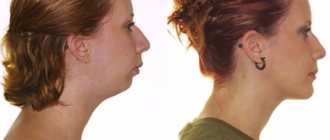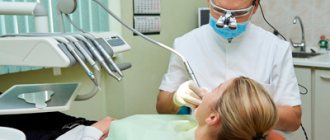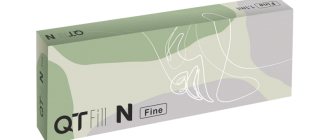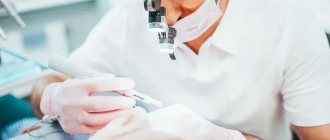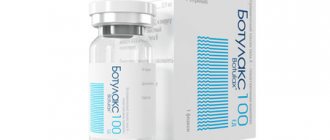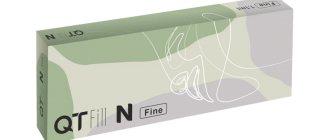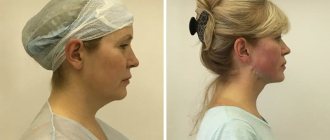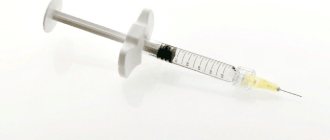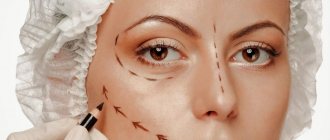It is generally accepted that beauty is expressive eyes, a straight nose and a high forehead. But it often happens that even a face with regular features seems ordinary.
This effect is also called the absence of “breed”, when the image is devoid of expressive lines and relief.
Expert comment:
“Have you ever wondered why many successful acting careers in Hollywood begin with correction of the chin and angles of the lower jaw?
The effect of "breed" and an expressive face is usually closely related to the shape of the cheekbones and lower third of the face. This is not always obvious, but it is they who form the general impression of harmony or disharmony of traits. That is why correction of the jaw, its augmentation, very often allows us to solve many appearance problems.”
Vasiliev Maxim, plastic surgeon.
Angelina Jolie
Tom Cruise
Our many years of experience in the field of appearance harmonization allows us to create an expressive jaw line that balances facial features, giving it the missing sculpture and breed.
We perform all procedures strictly after a series of anthropometric measurements and calculations, on the basis of which we individually select the size and shape of the implants. Only this approach allows you to not only make your jaw wider or narrower, but also get an attractive face on which even your worst friends will not find traces of surgical correction.
However, first, let’s figure out what is needed for a beautiful jaw.
What a beautiful jaw in men
Surely, when you hear the words “masculinity,” the first faces that come to mind are the Marlboro cowboy, Tom Cruise, or Sean O’Pry.
But if nature did not bother to develop a man’s chin area, then his appearance evokes completely different associations. Excessive softness, indecision, perhaps even weak character - these are the first impressions of a face with a small chin and soft lines of the lower jaw, even if their owner himself feels quite courageous and strong.
Expert comment:
“The reason for this perception lies in our subconscious.
Sex hormones are primarily responsible for how developed the bone structure of the lower jaw is. Protruding brow ridges, a strong-willed chin and a massive, square, well-developed jaw are testosterone traits. This is a sign of a healthy and strong man.
Such a man always attracts attention as a promising partner in his personal life and in business.
Enlargement of the jaw and chin brings the external appearance into complete harmony with the internal state of a person.”
Vasiliev Maxim, plastic surgeon.
FAQ
At what age is it recommended to have contour plastic surgery?
Injection contour plastic surgery has no age restrictions. If there are indications, the first correction can be made starting from the age of 18.
What is better for facial contouring?
All preparations used in EMC are of high quality and have proven themselves in contouring with hyaluronic acid.
Is it possible to tighten the contour of the face without surgery?
Yes, by introducing fillers you can correct the oval of the face, harmonize proportions, and make the angle of the lower jaw more expressive.
What a beautiful jaw a woman has
The structure of a woman's face has its own characteristics. In order to look beautiful and graceful, a woman needs chiseled cheekbones and a smooth jawline.
Despite the widespread dictate of Angelina Jolie's image, the convex angles of the lower jaw and protruding chin are a manifestation of masculine traits. A feminine jawline should be smoother, yet firm and well-defined.
To make the image refined and sophisticated, too pronounced angles of the lower jaw require delicate grinding of the bone tissue.
Jaw correction may be accompanied by chin augmentation and removal of Bisha's lumps to enhance the cheekbone line. These procedures allow you to tighten the skin under the chin, get rid of the double chin effect, and create a beautiful line of the chin-cervical angle.
Microsurgical operations of maxillofacial surgery
Microsurgery is a universal method used in almost all surgical disciplines to eliminate a defect in a particular tissue. In the human body, there are more than 400 donor sites with an axial type of blood supply, from which taking tissue does not cause any harm to the further blood supply of the entire organ. In the reconstruction of the jaws, the main place is played by the property of the flap with the presence of such a quantity and quality of bone that will make it possible to recreate the anatomical integrity of hard tissues and in the future the possibility of use for dental implantation and prosthetics .
For total and subtotal defects of the mandible, a fibular skin-bone flap . The fibula has sufficiently large supporting properties, having a fairly large amount of cortical component, and can be easily modeled to recreate anatomical contours. An iliac or otherwise inguinal skin-bone flap is optimal for the reconstruction of small defects of the lower jaw; in the latter cases, it is sometimes possible to use a free iliac bone.
For total and subtotal defects of the upper jaw, radial skin-bone and fibular skin-bone flaps are optimal. In cases where the defect covers the zygomaticomaxillary buttress in combination with a defect in the alveolar process, it is possible to fill the bone defect with corticocancellous parietal grafts and mandibular grafts taken from the ramus and mental region with free grafts of mesenchymal origin, which is optimal for reconstruction of the middle zone faces.
Of course, the dominant algorithm remains aimed at engrafting the flap on a vascular pedicle. If you have to choose between convenience for subsequent dental implantation in the form of the presence of a cortical plate of the bone component of the autograft in the area of the recreated alveolar process for subsequent implantation and this somehow reduces the reliability of the vascular anastomosis, it is necessary to choose the reliability of engraftment. Disputes often arise between implant surgeons and reconstructive surgeons about how the iliac bone should be positioned in the defect area, but experience shows that there can be no compromises, since in case of thrombosis of the vascular anastomosis, the entire flap is lost. It is also necessary to understand that the location of the spongy component in the area of the alveolar process does not interfere with subsequent implantation, since a new one is formed within 6 months.
To return and normalize chewing function and the ability to eat, it is necessary to have:
- 1. Lips and complex of swallowing organs.
- 2. Presence of jaws.
- 3. The presence of teeth and a bite that provides adequate chewing.
- 4. Presence of buttresses.
- 5. Stabilization of the TMJ.
- 6. Synchronicity of the masticatory muscles.
- 7. Mental balance of the patient.
In the literature, we did not find a specific algorithm or approaches aimed at returning such vital abilities as sucking and swallowing, chewing and normalization of speech function. To normalize the patient's nutrition, the presence of lips is necessary, otherwise salivation occurs, followed by maceration of the skin and the inability to receive and send food into the esophagus. Patients with defects of the soft tissues of the perioral area constantly suffer from gastritis, inflammation of the oropharynx, since the vacuum property of food evacuation into the esophagus is reduced, many adapt to swallow with an open mouth, throwing their head back; in the latter, the absorption of carbohydrates is impaired, since saliva takes part in cleansing the oral cavity from food residues, plaque and bacteria, thanks to its buffering properties, it neutralizes the negative effects of strong acids and alkalis within the buffer capacity, provides the supply of ions necessary for the remineralization of teeth, and has antibacterial, antifungal and antiviral properties. Claude Bernard proved that we recognize the functions of an organ by identifying the consequences of its absence. From the point of view of the functional return of the ability to eat, the second place in our algorithm is the presence of jaws. To eliminate defects in part or the entire jaw, we use preoperative planning.
Preoperative planning of the jaws is carried out using 3D visualization programs that allow modeling the sizes and shapes of autografts, taking into account the positioning of the condylar processes of the lower jaw in the temporal fossae (in the anterior-superior position in the articular cavities) according to CT scans. Despite the fact that we perform reconstruction in the previous bite, most often we have to deal with an already remodeled TMJ and a broken bite. Therefore, planning is necessary taking into account the subsequent achievement of centric occlusion in the centric relation. A functional study of occlusion consists of comparing central occlusion (CO-occlusion in which there is maximum contact between the teeth of the upper and lower jaw) and the central ratio (CO-condition in which the heads of the lower jaw occupy an anterior-superior position in the articular sockets). If there is a significant difference, a description of the differences is required. Thus, a significant difference between these conditions is more common with asymmetric deformations and with Angle class II deformities. Determining the CA is important for correctly drawing up an operational plan.
When planning the elimination of maxillary defects, we take into account the need to restore the buttresses, as well as the air supply of the upper jaw. Buttresses are the most important component for supporting the alveolar process, otherwise mobility of the upper jaw occurs after prosthetics.
Although restoration of the lost maxillary cavity and mucous lining is not possible, restoration of anatomical proximity is necessary, therefore filling the zygomaticomaxillary buttress with ilium is incorrect. It is optimal to use free split mandibular or parietal auto-bone blocks in shape in combination with bone with vascular nutrition. In the future, perhaps with the development of technologies for the use of stem cells, we will learn to restore the true mucous lining of the maxillary or paranasal sinuses.
In the reconstruction of the upper jaw, we use a fibular autograft for the reconstruction of total defects and a radial one for subtotal defects. When a radial skin-bone flap is subsequently used to place dental implants, it becomes necessary to reconstruct the second cortical-spongy layer of the alveolar process on the lingual side, which can be done using parietal or mandibular free autoblocks.
In maxillofacial microsurgery , when it is necessary to recreate bone curves, in the choice of grafts with bone, we are limited to iliac, fibular, and radial flaps, since only the latter allow 3D modeling of the bone component congruent with the defect.
of one-stage reconstruction after resection still remains open in the country . It is necessary to understand that if the reconstruction is not performed simultaneously with the resection of the jaw and even a temporary titanium structure is not applied to maintain the bite, remodeling of the temporomandibular joint occurs, both from the healthy and from the pathological side, and a violation of the trophism of the masticatory muscles. In these cases, before placing dental implants and before prosthetics of the implant, orthodontic fixation of the bite is performed in the form of braces and mini-implants, as well as muscle relaxation of the masticatory muscles on the part of the healthy jaw using Botex therapy or myotronic.
HISTORY OF THE PROBLEM
In our opinion, microsurgical autotransplantation for the purpose of jaw reconstruction has gone through several stages in its development:
Stage 1 – high-quality autograft collection, minimal modeling, and transfer to the recipient area. The main objective of this stage was to ensure graft engraftment (from 1978 to 1990).
Stage 2 included better modeling of autografts using conventional radiographs and wax templates. The main task of this stage was to restore facial aesthetics. The impaired function of the lower jaw was restored after a series of additional corrective operations and removable dental prosthetics (from 1990-1995). Stage 3 - computer modeling of the lower jaw and restoration of chewing function using prosthetics using dental implants. The main goal of this stage is to restore facial aesthetics and chewing function of the lower jaw without the use of additional corrective surgeries (from 1995 to 2011). Stage 4 - restoration of not only an ideal bite and stabilization of the TMJ, but also elimination of the imbalance of the masticatory muscles (in fact, this article opens the 4th stage in the history of maxillofacial microsurgery).
We have developed an algorithm for treating patients with jaw defects: 1. Preoperative 3D planning and production of stereolithographic and bite templates. Planning taking into account subsequent dental implantation and prosthetics. Selecting the optimal flap. 2. Restoration of buttresses, if possible, and the anatomical contours of the alveolar process of the jaws using free and pedunculated bone grafts. 3. Remodeling of the TMJ when eliminating subtotal defects of the lower jaw. 4. Dental implantation and prosthetics.
Microsurgical operation: resection of the lower jaw affected by the tumor with simultaneous reconstruction with a fibular graft on a vascular pedicle
| 1. Resection of the lower jaw affected by the tumor within healthy tissues | ||
| 2. Stage of control of resection according to the preoperative template | ||
| 3. Harvesting the fibula on a vascular pedicle | ||
| 4. Stage of modeling the harvested transplant using the author's device Karayan A.S. and Nazaryan D.N. | ||
| 5. Control of the simulated transplant on the preoperative template | ||
| 6. Fixation of the graft on the vascular pedicle to the remaining healthy fragments of the lower jaw | ||
| 7. Microsurgical stage: under a microscope, the vessels from the lower leg and the external carotid artery, jugular vein are sutured, after suturing the vessels, the clips are removed and the tissue taken from the leg is filled with blood, i.e. the flap becomes alive, but on the jaw. | ||
| 8. Control of blood supply - the final stage of microscopic surgery | Watch the video | |
| 9. The patient’s appearance before and after the operation will be practically unchanged; thanks to one-stage reconstruction, after 6 months the person will be completely rehabilitated | ||
In the scientific and clinical department of maxillofacial and plastic surgery of the Federal State Budgetary Institution NCCO FMBA of Russia under the leadership of Professor Karayan A.S. and Ph.D. Nazaryan D.N. Unique surgeries are performed to eliminate jaw defects. Such operations are performed only in 3 medical centers in Russia.
Renaissance and plastic surgery
So, how do you understand that the lower third of the face is underdeveloped and needs correction? Take a full-face photo of yourself and mentally or with a pencil, divide your face into three parts horizontally. The upper third of the face is from the line of the nose to the middle of the eyebrows, the middle third is from the middle of the eyebrows to the tip of the nose, and the lower third is from the base of the nose to the chin. Now take a ruler and measure these three parts.
In a harmoniously beautiful face, the distance from the hair growth to the eyebrow line, from the eyebrow line to the base of the nose and from the base of the nose to the chin is approximately the same.
Even Renaissance artists showed that on a proportional face these three parts are equal. If one of them is significantly larger or smaller than the others, the face is perceived as inharmonious.
Contraindications
The high safety of the gels virtually eliminates the possibility of complications after the procedure. However, in order to avoid an individual reaction of rejection by the body, contour plastic surgery is contraindicated in the following cases:
- diseases of the thyroid gland (consultation with an endocrinologist is required);
- blood clotting disorders;
- infectious diseases;
- skin diseases;
- the presence of other drugs in the filler injection area (be sure to tell the doctor about all the injections you have done before).
Non-surgical correction of the angles of the lower jaw with fillers
Is it possible to increase the angles of the lower jaw without surgery? If the bone deficiency is minor, we suggest trying fillers in the lower jaw.
Temporary increase in the angles of the lower jaw with filler.
Performed: upper blepharoplasty, ️installation of a chin implant, medial and lateral platysmaplasty with neck lift through an incision in the earlobes.
Performed by a surgeon - Maxim Vasiliev .
At Platinental we use Voluma, Radiess or Juvederm fillers for this purpose - they are quite dense, safe and create the desired contour for a long time.
The main disadvantage of increasing the angles of the lower jaw with fillers is that the effect is temporary: the gel is completely absorbed, and after two years the fillers will need to be reinjected.
However, this procedure can be considered a rehearsal. If you like the result, it makes sense to consider permanent correction of the angles of the lower jaw with implants.
How long does the result last?
Hyaluronic acid is a substance related to our tissues; it is completely biocompatible. This means that after some time it is eliminated from the body naturally - with the lymph flow. The volume achieved through injections gradually decreases. But it can be replenished again by repeating the injections.
Usually the result lasts for a year or a year and a half. Much depends on the individual characteristics of a particular patient, his lifestyle - for example. If you like active recreation and regularly play sports, hyaluronic acid will be removed from the body faster.
To make an appointment for chin contouring in Moscow, call us or use the online registration form on the website. The center's consultants will quickly select a convenient appointment time for you. We are located at: st. Marshala Rybalko, 2k6.
Jaw contouring with permanent implants
A much greater effect will be achieved by increasing the angles of the jaw using porous Medpor implants.
Expert comment:
“Medpor is a very dense porous biomaterial that has been known in plastic surgery for more than 30 years.
Medpor is ideally compatible with tissues and does not require special fixation to the bone. It grows with connective tissue and blood vessels and literally becomes “one” with its own bone tissue.”
Andrey Iskornev, plastic surgeon
We always start with careful planning of the operation. Our task is not just to build up the lower jaw, we look at the issue much more broadly and our goal is to create a beautiful, harmonious face. Enlarging your lower jaw should improve your appearance.
Therefore, in addition to experience in plastic surgery, the doctor must have artistic taste and an analytical mind.
All jaw angle implants are always selected individually in accordance with the concept of appearance harmonization. In difficult cases, a stereolithographic model of the skull is performed to plan the operation and select implants.
"Jolie angles" in young patients.
For young people and girls, the procedure is carried out to make their appearance sexy and similar to the stars ! Preference is given to contouring with fillers, although there is also the option of surgical intervention with implant placement.
Plastic surgery at a young age is not very desirable: as the practice of surgical corrections shows, the implant must be changed after 10-15 years.
Taking into account all the costs and harm to health, it is more profitable to visit a cosmetologist once every 13-15 months to introduce fillers into the area of the corners.
The volume of correction with fillers is 1-1.5 ml on each side, the cost ranges from 18,000 to 35,000 rubles, depending on the cost of the filler. With the cost of plastic surgery starting from 250,000, the costs are approximately the same.
When correcting, use 1-1.5 ml of the drug for each corner; fillers must be chosen dense so that they keep their shape for as long as possible.
The cost of correction is from 25,000 to 60,000 rubles , depending on the chosen drug and its quantity.
Correction technique - only a cannula!
A cannula is a long, flexible, blunt-ended needle that does not damage tissue and allows you to avoid bruising and large swelling after the procedure!
We promise to all our patients to do everything possible so that you leave our doctors’ office without hematomas!
Photos before and after correction of “Jolie angles”
How is plastic surgery of the angles of the lower jaw performed?
After planning the implant, it is time for surgery. It lasts about an hour under general anesthesia. We usually use intraoral access, so there are no stitches on the face after surgery.
Of course, jaw augmentation surgery, like any plastic surgery, requires time for rehabilitation. The recovery period lasts about two weeks, and for the first few days you will have to wear a bandage that helps stabilize the implant.
Subsequently, there is no danger of it migrating: the pores of the material from which the implant is made grow with connective tissue so that the implant simply grows into the bone tissue. The implant is installed once and for life, does not require replacement.
How does the procedure work?
Contour plastic surgery does not require any special preparation. Work is usually carried out in stages:
- examination, conversation with a doctor, determining the nature of the problem and the area of intervention;
- choice of drug (hyaluronic acid of different viscosities is used for different areas);
- drawing markings (lines along which the drug will be administered);
- application of anesthetic gel;
- injection of fillers using special thin needles.
Many representatives of the stronger half of humanity are concerned about the question of how painful the procedure is (oddly enough, facial manipulations for men often turn out to be more “sensitive” than for women). Let us reassure you: discomfort during injections is minimal.
After administration of the drug, the result can be assessed almost immediately. Correction of the chin in men allows you to achieve more masculine contours of the lower third of the face - it becomes more strong-willed.
